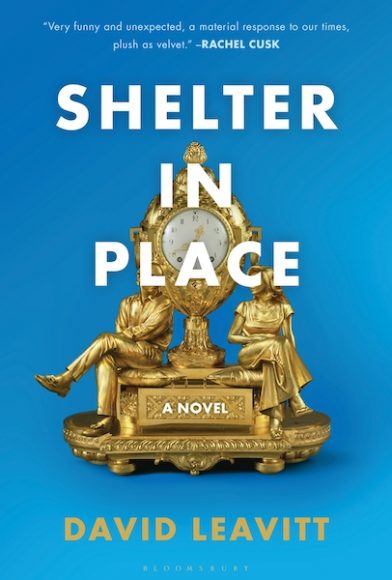Now, more than ever, we need a reason to laugh. Fortunately, writer David Leavitt has returned with his first novel in seven years. A thoroughly modern comedy of manners, “Shelter in Place” (Bloomsbury,$27, 384 pages) is both one of the best novels of the year as well as the most humorous. Set in the aftermath of the 2016 presidential election, Leavitt introduces us to his fabulous and expansive cast of characters, including husband and wife Bruce and Eva, Eva’s best gal-pal Min, interior decorator Jake, Eva and Bruce’s antagonistic neighbor Alec, Bruce’s secretary Kathy and Jake’s mentor Pablo, just to mention a few. Eva and Bruce are the novel’s nucleus, around which the other characters revolve. She is so desperate to get away following the crushing disappointment of the election that she is willing to leave the country for Venice. Bruce, a financial mastermind, is willing to do anything to keep her happy. Leavitt, recovering from an unexpected hospitalization for an appendectomy, was generous enough to take time out of his convalescence to answer a few questions about the book:
David, did you know when you first started writing your new novel “Shelter in Place” that it would take such a humorous direction?
“Various people have told me they have found it really funny. I think it’s revealing of me that I thought of it as a comedy, but I never realized it was actually funny. I was actually happy to hear that.”
I’m glad you said that because I’ve been describing “Shelter in Place” to people as a 21st century comedy of manners on par with predecessors such as Noel Coward and Joe Keenan.
“Oh, Joe Keenan. I’m so glad you mentioned him. I loved those books. He wrote those great novels ‘Putting On the Ritz’ and ‘Blue Heaven.’ They were among the funniest books I have read. Then when he went to the dark side — Hollywood — and he was writing for “Frasier,” I had a little bit of correspondence with him in which I think I said that I hoped he would write more books. It’s so funny that you mentioned him. Noel Coward was absolutely on my mind, but I must have had Joe Keenan in my subconscious. You’re a very good reader. I had not put that together.”
Did the inspired and timely title of the novel come before or after the pandemic?
“It came in November. I cannot claim credit for it. We had been having a very hard time with the title and it was my editor, Anton Mueller at Bloomsbury (who suggested it). He and I were having a lot of conversations about the fact that all the titles I was coming up with had to do with time. We both felt that the title needed to be about place. One day he called me up and said, ‘I have an idea for a title. I don’t know what you’re going to think of it,’ and he said ‘Shelter In Place.’ At that point, back in November I associated that with earthquake drills. I loved it and I thought it was a great title. There was a little bit of a hesitancy on the part of the marketing people — this is hilarious — that readers would not be familiar enough with the phrase. Little did any of us even begin to know. I think it was a bit of prescience, not on my part, on his part.”
In addition to the political themes threaded throughout the book, there are various insights into the world of interior decorating and decorators. Can you please say something about your interest in design and interiors and how much research was involved?
“I have always been sort of a touristic aficionado of interior design. The World of Interiors is my favorite magazine in the world. In fact, this summer, the postal issues and the delays in getting my issue from England have been a minor cause of stress. I’d always been very interested in interior decoration. My husband has a really good eye. He has that ability to take two or three things that I wouldn’t recognize as going together and see how they go together. My interest evolved through two sources. I was doing a lot of research at a certain point on Jean-Michel Frank. He was a French furniture designer and interior decorator whose heyday was the ’20s and ‘30s. He was a cousin of Anne Frank’s. He lived in Paris. Now, his furniture is enormously expensive. Yves Saint Laurent and Pierre Bergé had a bunch of (his) pieces.
“He had a very tragic life. He suffered from acute depression. He eventually left Paris in 1940 — all of this material mostly ended up in my novel “The Two Hotel Francforts.” He couldn’t get a visa to the States, so he went initially to Buenos Aires and had a brief career there. Then went to New York. He had an American lover who had essentially ended the relationship, and he was pursuing him. Jean-Michel Frank ended up committing suicide in March of 1941.
“Through my fascination with Jean-Michel Frank and his extraordinary story, I met a guy named Mitchell Owens who was then at Elle Décor and has now been, maybe for the last 10 years, at Architectural Digest. Mitch became a close friend of mine and my sort of window into the world of interior decorating and shelter magazines and all that. I was in regular touch with him. I would see him sometimes when I went up to New York. I was interested in the subject from a couple of perspectives. One was the whole question of where do you draw the line between an art and a trade. Which is something writers think about as well. It’s a much more complicated question when your art is one that requires rich clients. I had some fragments, dating back to as far as 2009, about the relationship between interior decorators, most of whom are gay males, and their clients, who are mostly women, and the sort of strange psychology and the sense of almost a second marriage.”
A codependent relationship.
“Exactly. In its earlier incarnations, the novel was in first person, Jake was the narrator, and it was very much focused on that. As it evolved, and it evolved because of the election of Trump, I always knew it was going to have to take place after a Republican election. Originally, I thought maybe after the Reagan election, then maybe after Bush two in 2000. But finally I realized this idea of wanting to flee and create a kind of a jewel box panic room in another country. I was thinking about Trump. I was obviously projecting all my own fears. That led me into the difficult question of how to write about the impact of politics on contemporary life without the book either becoming incredibly depressing or a kind of ‘political novel,’ which isn’t what I wanted it to be. It gradually seemed to me that the way to do it was comedy.”
You said something earlier about being a magazine reader and magazine publishing is sweetly skewered in the book, never more so than when Min begins a sentence “When I was at Mademoiselle …” or “When I was at Town & Country…” Do you think magazine readers are affected by the revolving door of writers and editors?
“The only magazines I subscribe to, aside from the London Review of Books, which is the outlier, are Architectural Digest, AD as it’s now called, and I get The World of Interiors and… House & Garden. I have been comparing, every month, the size of the issues. Britain still has a thriving print magazine industry as evidenced by the fact that their issues remain pretty thick. If you look at Architectural Digest, the most recent issues, they are like 50 pages.”
It’s that thin now?
“They’re so thin. All the priority at Condé Nast, from what I’m being told, is being shifted to the websites and the online material. I think the print magazine, even in areas where beautiful images are very important, is a dying medium in the United States. Maybe it’ll revive. I think it’s very sad that that’s happening. But at the same time I think there is a real ferocious belief in print. I agree with that. Now that Netflix has the power to pull movies or episodes of shows (out of rotation), I’m grateful that I have my old DVDs. I can imagine a future where if everything is electronic there’s no permanent record that can be consulted, like in an archive.
“Also, it’s just a reflection of my own experience. I know so many Mins. It seems to me, in the magazine industry, particularly when it was doing better, nobody ever kept a job for very long. Inevitably, when a magazine got a new editor, if you paid attention to the masthead you would see, ‘Oh, that was the former editor of X.’ I think editors determine the tone or the voice of the magazine. One reason I think “The New Yorker” is the exception to the rule is because it’s had so few editors. David Remnick’s been there forever, so there’s a certain consistency. Whether it’s good or not is another question, but at least it’s consistent.”
Dogs are also very much a part of the cast of characters, Bruce and Eva’s Bedlington Terriers Caspar, Isabel and Ralphie, and Alec’s Sparky. Do you consider yourself to be a dog person?
“Oh, totally. I have a Bedlington Terrier. I only have one. But those three dogs are based on my dog, who is the same breed. I don’t ever want to write another novel that does not have a dog in it. “
Writers also don’t escape the wrath of some of the characters. Does Lydia Davis know she’s a character in the book?
“I haven’t told her. I don’t know her very well. That reading was actually based on a reading by my friend Rachel Cusk that was at Greenlight Books. I attended that reading, so a lot of the detail for that scene came from Rachel’s reading. But I have heard Lydia read. I suppose what I was mostly interested in doing there was sending some nonliterary people to hear a sort of super-literary, super-refined writer whose audience is almost exclusively other writers. The idea of having someone like Bruce, who doesn’t really know very much, hearing Lydia Davis, seemed to me to have a lot of comic potential. One of my favorite lines is Bruce’s description of her stories being like things you hear people saying into their cell phones on the subway. That was an opportunity for me to create some comedy. At the same time, I don’t think there’s anything in it that Lydia would be offended by.”
“Shelter in Place” is extremely cinematic. If there was a movie version, who would you like to see as Jake, Eva, Bruce and Min?
“Oddly enough for me, I haven’t thought about it that much. Off the top of my head, I’m thinking Nicole Kidman could be a good Eva. But I really do need to think about that. It’s funny, because I usually cast my novels, but I haven’t with this one. That that will be something for me to do during my convalescence.”
For many authors, book tours appear to be on hold for the near future. Do you have plans for virtual events?
“I’m doing a number of them. They haven’t been scheduled yet. I know I’m doing one at Square Books in Oxford, Mississippi. I’m doing one at a bookstore in San Francisco and one in Saint Paul. There should be more, including one in New York, as we continue. I keep meaning to put it on my own website, but it was one of the many things that I was completely waylaid from doing by this unexpected descent into the weirdness of hospitals in the age of Covid.”
For more, visit davidleavittwriter.com.





